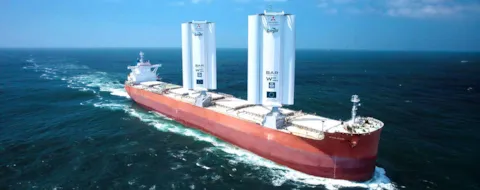Wind-assisted propulsion system in a nutshell
Wind-assisted propulsion system (WAPS) technologies have gained significant attention in the shipping industry as a means of reducing fuel consumption and emissions. These technologies harness the power of wind to supplement the propulsion of a vessel by generation of aerodynamic forces. They have the potential to significantly improve the efficiency of shipping operations and make a meaningful contribution to the decarbonization of the industry, as wind is an inexhaustible, free, zero-carbon energy source.
Sail systems
Several different sailing technology concepts have been or are being developed, including rigid or soft wing sails, Flettner rotors and ventilated foils, or kites. Most modern systems now utilize state-of-the-art intelligent control and automation systems to operate in a safe manner and without the requirement for additional crew. A combination of advanced aerodynamics, automation, computer modelling and modern materials is unlocking a new generation of innovative sail systems for ocean-going ships.

The technology potential of wind-assisted propulsion system
WAPS have already delivered fuel savings of between 4.5% and 9%, according to vessel owners and operators, and have the potential to achieve savings of 25% if installed as a retrofit. The margins are potentially higher if newbuilds are particularly designed to carry sail systems.
In the energy efficiency indices, WAPS is categorized as an “energy harvesting” technology, due to its physical principles of utilizing wind to directly provide additional thrust. Uncertainties in operational cost remain with the weather, but the advantages of sailing can be enhanced with weather routing algorithms to generate optimal routes for individual vessels. There are also several challenges to the widespread adoption of WAPS, such as the need for reliable and efficient technologies that can operate in a variety of conditions.
How DNV can help you
Class services for wind-assisted propulsion systems
DNV is collaborating with clients to take WAPS technology from a concept to mainstream use – applying our technical standards and relevant services to help provide guidance on compliance with regulatory requirements.
Maritime Advisory services for wind-assisted propulsion systems
Our advisory experts offer our clients a wide range of services to assist them in various aspects of the decision-making leading up to a WAPS installation, and furthermore support during operation.
Related articles, news, services and more
WAPS white paper for download
Learn more about how WAPS can help you to comply with GHG regulations
Energy Efficiency report for download
Learn more about energy-efficiency measures and strategies for different ship types
Energy Efficiency webinar now available to watch
Watch the on-demand webinar on Energy efficiency: Key solutions for maritime decarbonization
Lidar application on board for improved wind measurement
Gain insights into how this tool can be useful for WAPS from a DNV publication for the 10th Hull Performance & Insight Conference
Where does wind power fit into shipping’s green technology solution space?
Listen to the Maritime Impact podcast
Wind propulsion for RoRo, RoPax and pax vessels
Read the Maritime Impact article
Always on schedule with rotor sails – a captain tells his story
Read the Maritime Impact article
More commercial ships utilize wind technologies to cut emissions
Read the Maritime Impact article
Oceanbird ro-ro: Embarking on a new era of wind propulsion
Read the Maritime Impact article
Wind-assisted propulsion can cut fuel costs and emissions
View the Maritime Impact slideshow
Wind ships ahead
Read the Maritime Impact article
Benefits and challenges of new wind-assisted propulsion systems
Read the Maritime Impact article
Alternative Fuels Insights for the shipping industry
Explore our platform evaluating the uptake of alternative fuels and technologies
Decarbonize shipping - information hub
Get insights and various free content resources
Maritime Forecast to 2050
Download the Maritime Forecast to 2050 to uncover key trends shaping the future of shipping
